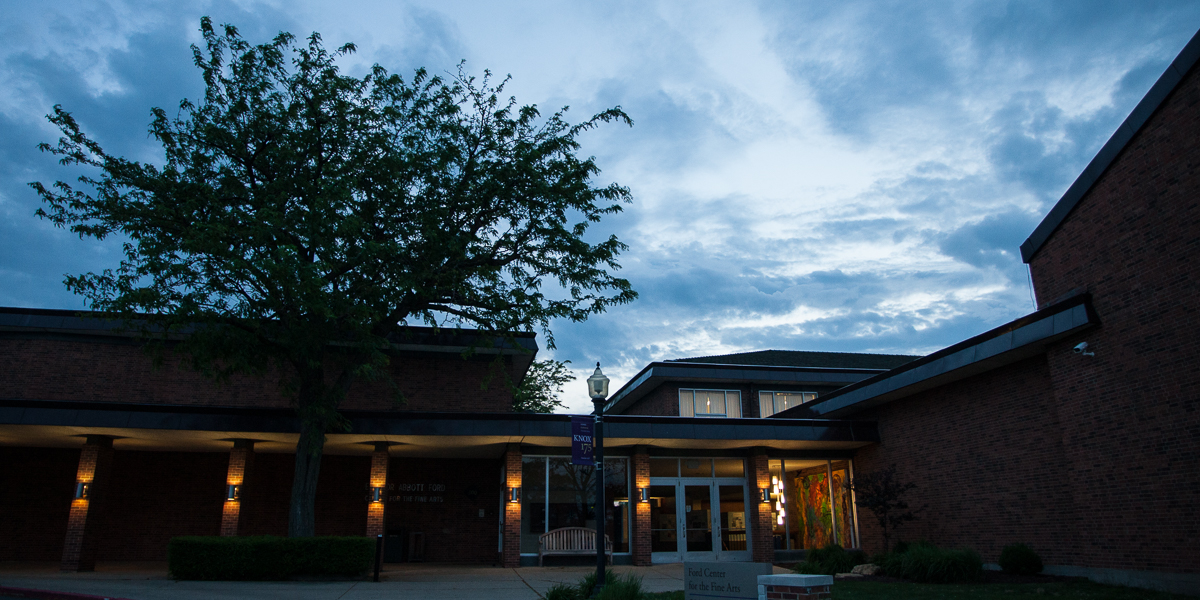


Office of Communications
2 East South Street
Galesburg, IL 61401

Story by Rebecca Beno
Photographs courtesy Edward Dale, Antonina Pondo and Rose Worthen
Small Pacific Ocean waves approach the western shore of Costa Rica, gently rolling on the sand. Night has fallen and all earlier sounds of the day are hushed. It's mid-December -- the end of the rainy season and the beginning of tropical summer. At first glance, you'd think there's nothing happening in this serene and exotic setting. But as their eyes adjust to the darkness, three Knox students see the top of a streamlined shell come into view.
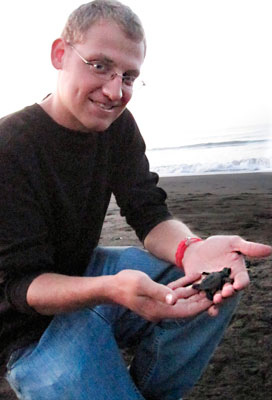 A female Leatherback sea turtle is digging, burying her eggs. While her male counterpart resides permanently in the water, the mother conceals her eggs on the beach. There are the typical predators, such as birds, but people are the main reason that all seven kinds of sea turtles are currently listed as Endangered Species.
A female Leatherback sea turtle is digging, burying her eggs. While her male counterpart resides permanently in the water, the mother conceals her eggs on the beach. There are the typical predators, such as birds, but people are the main reason that all seven kinds of sea turtles are currently listed as Endangered Species.
The biggest threat to sea turtles is poaching, although tourists on the beach at night with flashlights can disorient nesting turtles, scientists say. The people on the beach tonight -- Knox College seniors Edward Dale (photo right) of Roscoe, Illinois, and Antonina Pondo of Morton Grove, Illinois; and junior Rose Worthen of Helena, Montana -- are here to observe, and possibly help conserve, sea turtles.
Working in teams at night during their three-week stay, the students kept logs of turtle nesting locations, and the number of eggs and nests destroyed by animals and poachers.
Dale, Pondo, and Worthen began looking last fall for a volunteer project in Costa Rica that they could complete while on Knox's winter break during the month of December. They eventually found the uVolunteer -- an organization that links volunteers with educational, community development, conservation and service projects in Costa Rica and ten other countries in Asia, Africa, Central America and South America.
"I definitely had an affinity to sea turtles when I was a kid," Dale says. "I did a report on sea turtles in second grade about the different species, their eating habits, the impact of humans, and the TED -- Turtle Excluder Device. It's a mechanism built into shrimp nets allowing turtles to escape as the shrimp are caught."
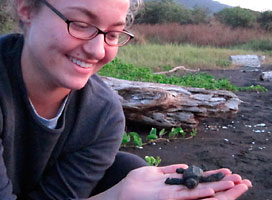 A chemistry and biochemistry major who came to Knox from Roscoe, Illinois, Dale says his future studies will focus on organic chemistry rather than field biology. "I plan to pursue research as a career," he says. "I hope that I can do some research that is directly applicable to nature and organisms." Pondo (photo right) is from Morton Grove, Illinois and majoring in biochemistry and modern languages. Worthen (photo below) is an integrated international studies and modern languages major from Helena, Montana.
A chemistry and biochemistry major who came to Knox from Roscoe, Illinois, Dale says his future studies will focus on organic chemistry rather than field biology. "I plan to pursue research as a career," he says. "I hope that I can do some research that is directly applicable to nature and organisms." Pondo (photo right) is from Morton Grove, Illinois and majoring in biochemistry and modern languages. Worthen (photo below) is an integrated international studies and modern languages major from Helena, Montana.
uVolunteer's sea turtle conservation project in Costa Rica required only basic knowledge of Spanish -- that and $765 per person for the first two weeks and $126 for each additional week. Pondo, Dale and Worthen sought help from Knox; they met first with Stephen Bailey, former associate dean of the college and currently director of Knox's Center for Research and Advanced Studies, and then with Xavier Romano, dean of students and vice president for student development.
Bailey helped the three apply for Richter Memorial Scholarships, a program that provides Knox students with small grants for research-related expenses. Romano awarded the students small grants to partly offset their living expenses and travel.
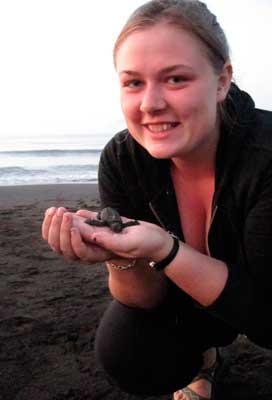 "The college was very supportive," Worthen says. "We are writing a paper, and we will give a presentation on campus for people who want to hear about our experience. It's a way to give back to the Knox community."
"The college was very supportive," Worthen says. "We are writing a paper, and we will give a presentation on campus for people who want to hear about our experience. It's a way to give back to the Knox community."
uVolunteer placed the three students with an on going sea turtle research project in Costa Rica's Camaronal National Wildlife Refuge, a year-round nesting site for Kemp's Ridley, Leatherback, and Hawksbill turtles.
Worthen, Pondo and Dale packed sleeping bags, bug-spray, mosquito nets, and flashlights. The temperature, by the students' estimation, was usually between 80 and 90-degrees F. According to Pondo, the best sleeping was in a hammock outside, due to the possibility of a passing breeze.
"The living was rustic, definitely, but it was more than adequate," says Dale. The research site -- a five-hour bus ride from San Jose -- has electricity, telephones and running water.
After dinner on the first evening, site staff gave presentations to new volunteers on sea turtle conservation. "In the middle of the presentations, someone called us out to the beach because baby Leatherback turtles had hatched, and they were beginning their journey out to sea," says Pondo. "We all ran to the beach and came upon a nest with these little guys. It was the most lucky thing to see our first night there. Witnessing a nest hatching was a great surprise and an amazing way to start our experience."
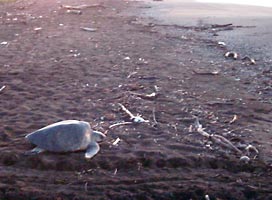 A staff biologist at the project showed the students how to follow turtle tracks and find nests. "He also demonstrated how to locate the eggs in the nest, pulled a couple out, and then let us remove the rest. He then showed us where to relocate them and how to rebury them," Dale says.
A staff biologist at the project showed the students how to follow turtle tracks and find nests. "He also demonstrated how to locate the eggs in the nest, pulled a couple out, and then let us remove the rest. He then showed us where to relocate them and how to rebury them," Dale says.
"Their trust in us strengthened as we showed we could handle the work," Dale says. "Eventually we were doing night shifts without the biologists."
Because turtles are nocturnal, the volunteers work through the night in three shifts. Their presence also was designed to deter egg poaching -- according to researchers, it's one of the biggest threats to sea turtle survival.
"Most poachers are teenagers," says Worthen. "If a kid grabs a nest of eggs it's $20 -- pretty good money for that age. If the poachers get caught by authorities, then they get fined." The volunteers on the beach seem to deter poachers, Worthen says. "We were there mainly as intimidation."
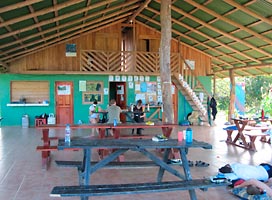 In order to promote conservation, the students said that station and the park rangers give presentations in local communities, which are starting to see the benefits of preserving and protecting sea turtles.
In order to promote conservation, the students said that station and the park rangers give presentations in local communities, which are starting to see the benefits of preserving and protecting sea turtles.
"Eco-tourism is increasing because watching sea turtles is becoming popular. The men from nearby towns are starting to learn English phrases to help them communicate with the tourists," says Worthen. "I helped translate. It was really rewarding to use my Spanish and help with communication."
Pondo, who has taken upper-level Spanish courses for her major, said that speaking with local residents and park rangers improved her language skills. "Costa Ricans know that we're trying to learn the language. This was one of the times I was constantly immersed in Spanish. It was a great learning experience," says Pondo.
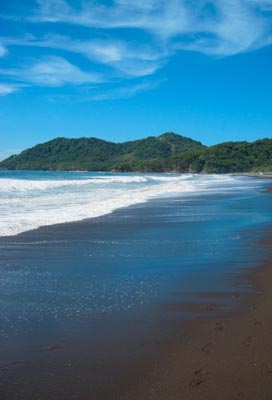 Pondo, Worthen and Dale all say their volunteer work was a positive experience, but it also demonstrated how much is left to be done.
Pondo, Worthen and Dale all say their volunteer work was a positive experience, but it also demonstrated how much is left to be done.
"In order to save sea turtles, the focus of the local economy needs to shift to eco-tourism. It needs to involve Costa Rican communities so they see the benefits of tourism and not just the short term income from poaching turtle eggs," says Worthen. "Sea turtles have lasted 110 million years. We owe it to the turtles to help keep them here."
Founded in 1837, Knox is a national liberal arts college in Galesburg, Illinois, with students from 47 states and 48 countries. Knox's "Old Main" is a National Historic Landmark and the only building remaining from the 1858 Lincoln-Douglas debates.
Published on February 15, 2010